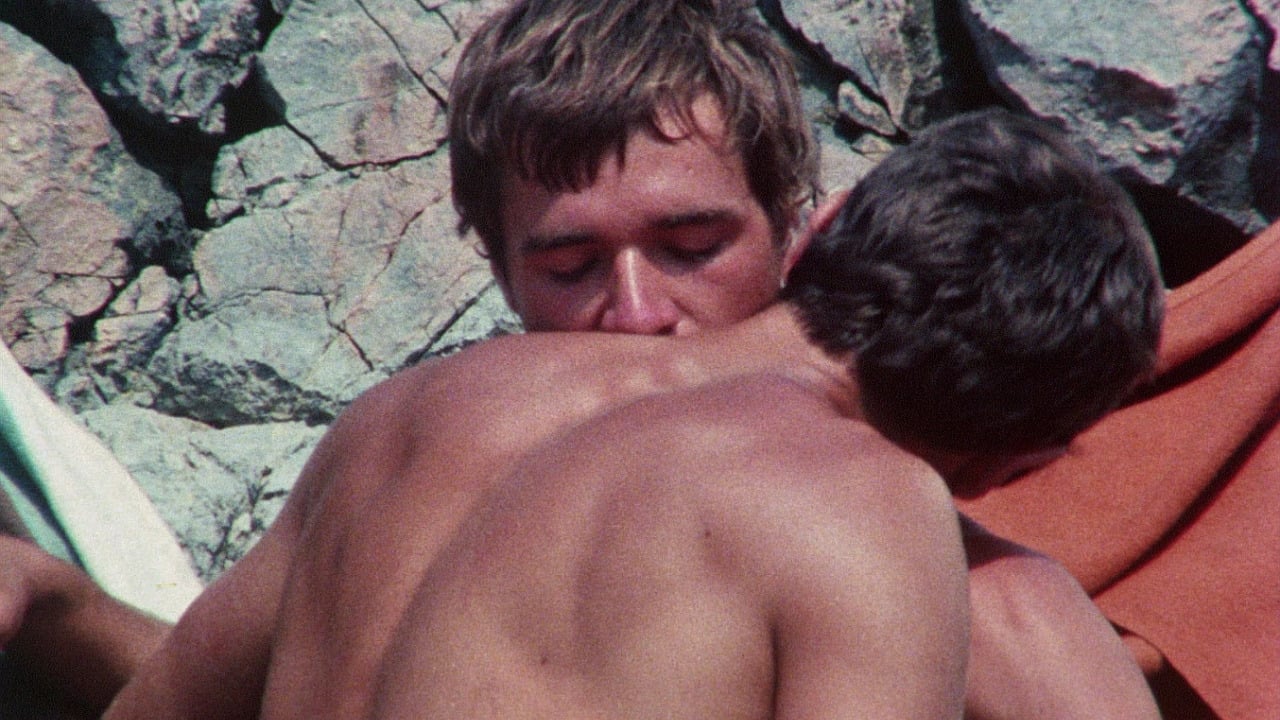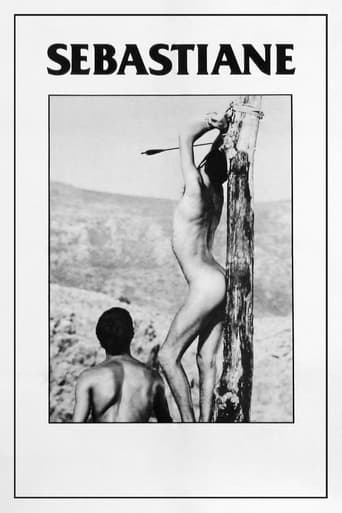

Memorable, crazy movie
... View MoreIt's fun, it's light, [but] it has a hard time when its tries to get heavy.
... View MoreIt really made me laugh, but for some moments I was tearing up because I could relate so much.
... View MoreWhile it is a pity that the story wasn't told with more visual finesse, this is trivial compared to our real-world problems. It takes a good movie to put that into perspective.
... View MoreThis film is not a religious film. But this film is not an anti- religious film. This film is about the rejection of a group of men banned out of society to some outlandish deserted area and what happens among them who have nothing to do and are under the command of an officer who is banned exactly the same way. First they are obsessed by sex since it is the main human activity they cannot have, at least in a normal heterosexual way. So they live that sexual obsession in jokes, in some brutality, in some dreams or some homosexual surrogate activities. But even so hunting a wild pig and killing it, having fake fights with wooden weapons are definitely not enough to satisfy their frustrations and their desires. If you are the officer you can order one simple soldier to satisfy your sexual impulse, but otherwise we are in a plain case of playing or raping. The film, apart from showing the homosexual relation between two soldiers reveals the fact that there are two Christians in the group and they are taken as scapegoats. One of them is Sebastian and he is tortured by the officer and by the soldiers because he refuses to fight because Christians do not fight. The officer takes a great pleasure in whipping him, torturing him day and night, tying him down in the sunshine for hours, trying to force him to accept to let him make love to him, and strangely enough he does not rape him though Sebastian refuses to service him. The soldiers do not touch him because he is the officer's prey, toy, possession. But they get even with the second Christian they torture physically just because he is a Christian. That is segregation and racism, hostility based on pure and simple religious rejection. The person who is not like you, who is different from you is a natural prey to your frustrations and compensations of these.Then the killing of Sebastian the way it is known in Catholic and Christian folklore is of course staged by the officer who makes each man shoot one arrow at Sebastian and even the second Christian is forced to shoot his own arrow, and Sebastian is abandoned to die of his wounds in the sunshine. But the film is targeting a far more important and universal theme. Anyone who is different is the potential victim of such persecution, and Derek Jarman is of course speaking of men who are gay in our society, at least in his society in 1976 and how they were rejected, ostracized, violated, raped, brutalized and even persecuted by the police. And beyond this sexual segregation the human species, hence humanity, has always cultivated segregation, persecution and apartheid against those they classify as different. The human species, hence humanity, is a segregative species. This is a deeply pessimistic vision but the evolution on such a subject is slow, very slow, and can take two steps forwards and three or four backwards just afterwards. The most fascinating and strongest aspect of the film is the way Derek Jarman show suffering as being a beautiful experience. Sebastian transforms his torture into a direct contact with Jesus and God. He transforms the sun into the kiss of God. He finds his love in his being tortured, but his love goes to Jesus and God because his suffering is the proof of Jesus's and God's existence: they exist because he believes in them and because he is made to suffer because of this belief. His suffering casts his belief in bronze and Jesus and God in gold. Then the plastic beauty of these bodies mostly nude or quasi-nude is just the mirage that Derek Jarman sends into our minds and our eyes: the mirage that the film is only about the beauty of male bodies, these bodies that are nothing but vanity because the only important thing is not the bodies of these men but their moral or ethical integrity, and then life and death are like the two sides of the same coin when you are a Christian. Life is dedicated to longing for death to rejoin the company of Jesus and God. And death is the escape door from the limited and locked up physical life into the eternal life of the soul in communion with God and Jesus, in absolute union with them. When we finally reach that understanding, that deep communion with man's spiritual dream and project, the fact that they are in the nude, undressed does not count any more We do not see it any more, or we do not feel any appeal in that nudity.That's the real project of Derek Jarman: to make us reach beyond erotic or pornographic voyeurism to lift our souls and minds to the contemplation of purity in the midst of total perdition and sacrilege, perdition of human integrity and sacrilege of human perversity. This film should thus not be restricted because it is the most beautiful lesson of visionary enlightenment.Dr Jacques COULARDEAU
... View MoreDerek Jarman was, like his contemporary Peter Greenaway still is, a visual artist working in film. The usual obsessions of the movie industry didn't occupy him overmuch. Psychology, character development, narrative, plot - all those were secondary considerations, if they were considered at all. The main preoccupation was the expressive power of the the image. To those of us reared on conventional, industrial cinema, this makes Jarman's (and Greenaway's) work both refreshing and frustrating in equal measure. SEBASTIANE is not, then, a conventional film. It would be misleading to assess it in conventional terms. At times it is jokey, revelling in its low budget and independent spirit. At other times, it is so beautiful it takes your breath away. And at other times it seems to crawl along, with dull acting beneath a luxuriously blue Sardinian sky.Leonardo Treviglio is a stunning, intense Sebastian, a Renaissance painting come to life. As his tormentor Severus, Barney James successfully conveys frustration and bewilderment behind his icy-grey eyes. Richard Warwick (probably the best known actor, having made a mark as one of the young rebels in Lindsay Anderson's IF...) is quietly impressive as Sebastian's only friend in the outpost. A lot is required of Neil Hamilton as the gruff Maximus, which is a pity because he is unconvincing enough to be a distraction. Personally, I think SEBASTIANE succeeds as a cinematic study of the isolation at the centre of martyrdom. It doesn't indulge in psychological speculation. It simply depicts some of the temptations, struggles, and sufferings involved. The sensuality of the lives of the other soldiers is at odds with the kind of life Sebastian wants to live. Jarman and his co-director (and editor) Paul Humfress show all this with great clarity.However, one of the side-effects of such clarity is emotional detachment. We watch as if the film were an installation in an art gallery. Nothing wrong with that, as long as you remember that's what you're looking at. Otherwise you might emerge from SEBASTIANE thinking that it's a failure, a halfway-house between an art-film and a porn-movie. For me, though, it's pretty successful on its own terms. And because it was a pioneering piece of film-making in other ways (Latin dialogue, gay lovemaking, self-conscious anachronisms), SEBASTIANE will always have a place in cinema history.
... View MoreAs soft porn erotica for soft porn erotica sake goes, this isn't a bad production. Obligatory hunks prancing around a remote seaside Roman political refugee camp in their diapers and assorted battle garb, these boys have too much time on their hands, so Roman sexual behavior being what it was in those days, there's a fair amount of male-male hanky panky going on plus the main story of the task master guard in(unrequited)love with the Christian pretty boy movie namesake: Sebastiane.Well after much nothing but fondling and slo-mo body contact the story progresses to the grand finale which is obviously a play on our hero's name in relationship to biblical characters. Don't wanna have too many spoilers here, but if you have some time to kill and nothing better to do, might as well see what 30+ year old gay films passed off as historical drah-mah is all about.
... View MoreNot being overly familiar with Bible stories or Christian history (and the fact that the opening rolling titles are impossible to read), the factuality of this film will escape me. But Jarman is a visual artist, and his film has more in common with the many paintings of Sebastian than it does with factual storytelling. Jarman's ornate decor can sometimes feel dull and bland -- his films can seem lifeless, bogged down by the set decoration. This calls to mind "Velvet Goldmine," a complex film I didn't care for, even though I love Todd Haynes; I want to like Jarman -- I love his books -- and this is the first film of his that I've been actively enthusiastic about. It has much more to do with sex than history; and it's apolitical and political at the same time.Consider the film's approach to homosexuality. No one is defined as being a homosexual, so that at first seems like a de-politicization of sex -- all there are are acts, and acts are not political. But at the same time, it's acts that are disdained and made illegal, and without the "political" approach to defining (and thereby defending) people as homosexuals, it leaves the acts open to censorship and condemnation -- politicization. As a film itself, though, it is not pedantic or accusatory -- in fact, Sebastian is killed, it seems, because of the lust of Severus, who he refuses. Like the Christian God who Sebastian loves and sees as more beautiful than Adonis, Severus wants Sebastian. But it isn't just condemning lust, either -- Anthony and Adrian are openly lovers, and the abundance of male nudity, and the eroticism of it by Jarman, could hardly be called prudish. In fact, there is a scene at night of the men grabbing each other, their dark-lit bodies, and the soldier pressing his near-naked, muscled body on his lover, that still seems shocking in its passion today.It's more like a lyrical tone poem, and Brian Eno's New Age-y score goes well with that. Jarman isn't a bully, and when the crucifying comes around he doesn't bludgeon us -- first we see a close-up of his face, as arrows pierce through Sebastian's skin, silently with the exception of the wind, and Jarman gives us one final distorted image to meditate on the death of the one we can't have. 9/10
... View More